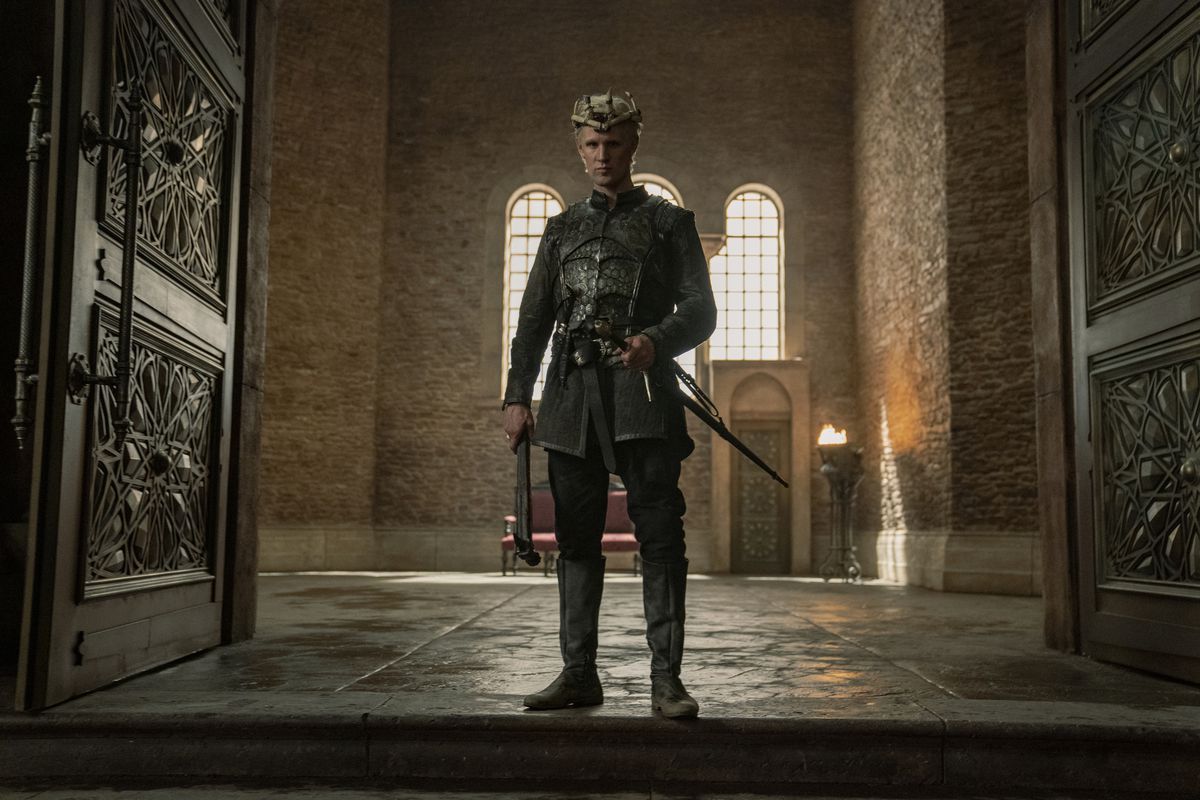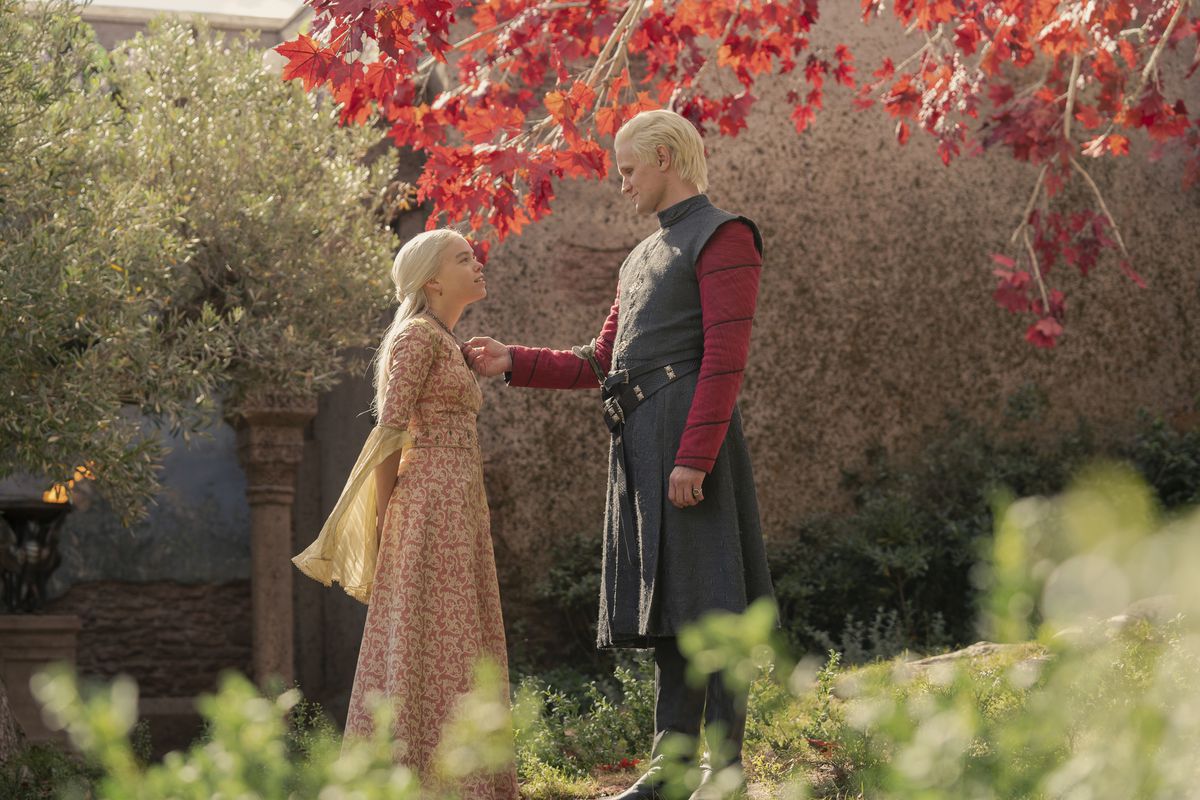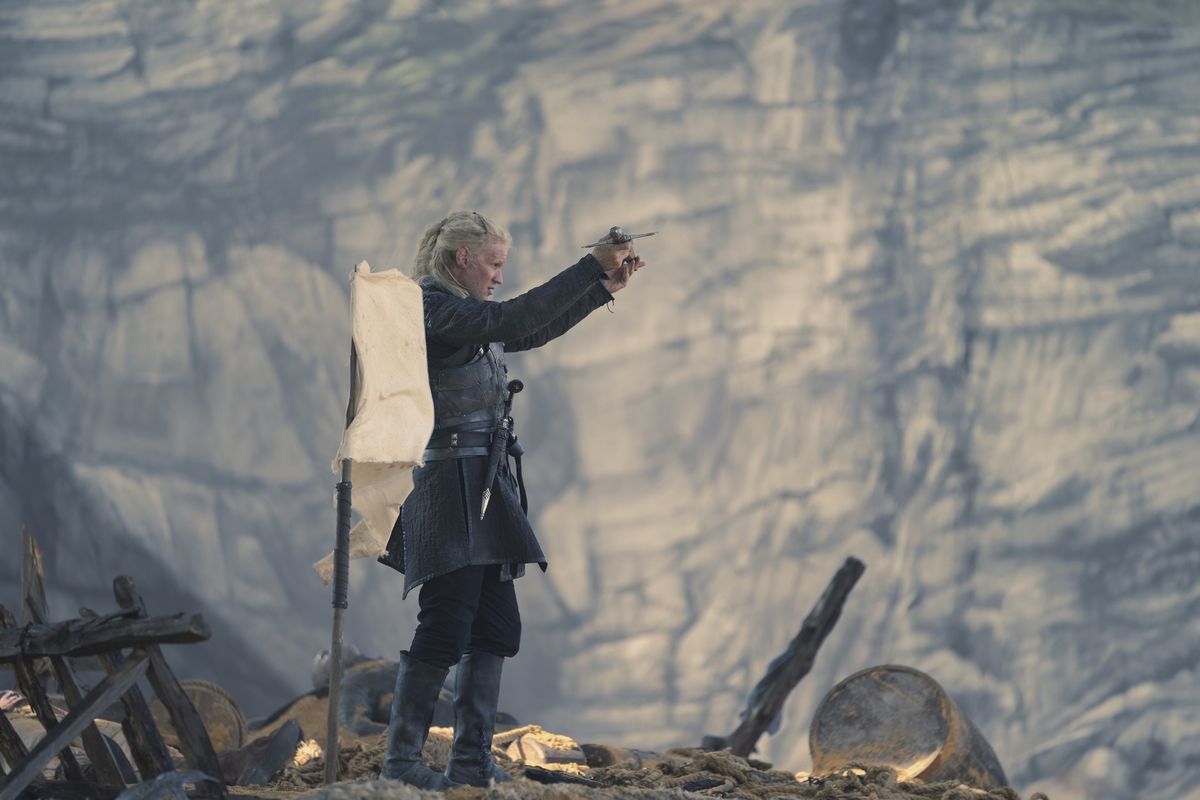Throughout Daenerys Targaryen’s rise to power in Game of Thrones, the specter of her father, the Mad King Aerys, looms large. In the course of the series, as Daenerys experiences setbacks and successes in her quest for the Iron Throne, numerous characters, from Barristan Selmy to Tyrion Lannister to Varys to Jon Snow, question whether she will ultimately exhibit greatness or succumb to the genetically predisposed madness of her line.
Similarly, House of the Dragon uses the memory of a prior king known for his brutality and cruelty to inform the characterization of one of its central characters, Prince Daemon. The repeated invocations of King Maegor the Cruel in relation to Daemon throughout the series are no accident. But who exactly was Maegor the Cruel, and what is the show trying to say about Daemon by creating this link between the two?
The abomination on the Iron Throne
Photo: Ollie Upton/HBO
Maegor the Cruel was son of Aegon the Conqueror and the third Targaryen ruler of the Seven Kingdoms. Like his descendant Daemon, he was a second son, with his elder half-brother Aenys the heir to Aegon’s throne. Where Aenys took to cerebral pursuits, Maegor was more of a jock. When he turned 13, his mother Visenya gifted him her Valyrian steel sword Dark Sister, and he was knighted by his father at the age of 16, making him the youngest knight in the realm at the time.
Despite their different proclivities, Aenys and Maegor got along well enough. When Aegon died, Aenys declared to his brother, “We shall rule this realm together, you and I,” but in practice, Aenys alone was crowned. Maegor did help his brother (brutally) put down several rebellions and was named Hand of the King. Yet the brothers fell out over a marriage. After 13 childless years with Ceryse Hightower, Maegor decided to take a second wife, an act which so affronted the Faith of the Seven and so upset the common folk that King Aenys gave him an ultimatum: Set aside his second wife, or go into exile. Maegor chose exile.
He returned when Aenys died suddenly, but rather than bend the knee to Aenys’ heir, Maegor’s nephew Aegon, Maegor claimed the Iron Throne for himself. Eventually, Aegon began rallying forces to press his claim, prompting Maegor to meet him in battle atop Balerion the Black Dread — the largest of the Targaryen dragons in Westeros. He slew his kin (and the true heir to the Iron Throne), earning him the sobriquet “Maegor the Cruel,” as well as a black mark as a Kinslayer, believed to be one of the most cursed and dishonorable things anyone in Westeros could be.
Maegor’s conflict with the church and his capacity for cruelty escalated when he took a third wife, prompting a religious uprising led by the Warrior’s Sons and the Faith Militant (the military arms of the church). The uprising ended when Maegor used dragon fire to burn the Sept of Remembrance and everyone inside it. He then ordered the construction of the Dragonpit where the church once stood. In other construction-based atrocities, Maegor celebrated the completion of the Red Keep by throwing a massive three-day feast for everyone who worked on its construction; when the feast ended, he executed all the workers to ensure he would be the only one with full knowledge of its many hidden chambers and secret passageways.
Maegor’s rule of six years and 66 days concluded when his gruesome and mysterious death launched one of the great urban legends of the Seven Kingdoms. It ended as it existed, drenched in blood.
Maegor reborn

Photo: Ollie Upton/HBO
Just as the Mad King looms over Daenerys throughout Game of Thrones, Maegor is held up as a comp to Prince Daemon, in ways both obvious and subtle, throughout House of the Dragon. In episode 1, Otto Hightower overtly warns that naming Daemon heir risks giving the realm another Maegor the Cruel. Much of that sentiment arises from Otto running his own long game to gain control over the line of succession, but there are kernels of truth underscoring the comparison that helps it resonate.
Like Maegor, Daemon is a second son, and like Maegor, his claim to the throne is usurped by his brother’s child. Both wielded Dark Sister. Both achieved military fame and glory fighting pirates in the Stepstones. Both are considered warriors compared to their more bookish brothers. And both were exiled by their kingly brothers for their transgressions. But despite Otto’s assertions, Maegor remains more of a worst-case scenario for Daemon’s progression than a reflection of who he is when House of the Dragon begins.
By episode 2, however, Daemon is seemingly leaning into the comparison for his own ends: Exiled from court, squatting on Dragonstone, desperate for his brother’s attention, he steals a dragon egg for his unborn child via a woman he announces he intends to marry — despite the fact that he’s already married to a different woman. While it is the dragon egg which ultimately lights the spark under Viserys, Daemon’s (ultimately false) declaration of his intent to take a second wife immediately calls to mind Maegor’s history with polygamy and the way his desire to marry and marry again led to significant struggles with the church and tremendous bloodshed throughout the realm. The standoff at Dragonstone represents Daemon at arguably his most Maegor-like yet.

Photo: Ollie Upton/HBO
While House of the Dragon is amplifying the Maegor/Daemon comparison — the Dragonstone standoff is almost entirely a creation of the show, adding heightened drama and cinematic panache to what is a quick aside in Fire & Blood — showrunners Ryan Condal and Miguel Sapochnik are ultimately picking up on what George R.R. Martin put down, as the parallels between Maegor and Daemon come from the text of the book itself. Just like the showrunners, Martin clearly wants readers to hold Maegor in their minds as they read about Daemon (and readers of Fire & Blood know the Maegor/Daemon comps aren’t done yet), to worry alongside Otto Hightower and the rest of the realm that Daemon is leaning too far into that comparison.
Thankfully, Rhaenyra is able to defuse the situation in episode 2 — and Daemon proves himself better than his great-grand uncle when he doesn’t strike down his niece, the person elevated above him in the line of succession. In episode 4, Daemon returns to court and patches things up with Viserys, only to be thrown out again after being caught nearly hooking up with Rhaenyra (important to note: one of Maegor’s six wives was his niece). But the story of Daemon Targaryen isn’t over, and the specter of Maegor will continue to loom over him as he moves deeper into the Dance of the Dragons.
Just like the narrative tension created by the question of which way Daenerys’ coin would land, House of the Dragon is invoking the memory of the cruelest Targaryen ruler to tease the worst-case scenario for Daemon’s character arc.












